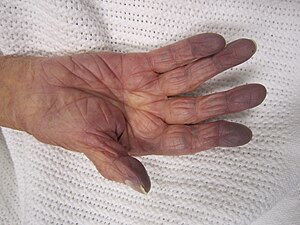Central cyanosis
| Cyanosis | |
|---|---|
 |
|
| Cyanosis of the hand in someone with low oxygen saturations | |
| Classification and external resources | |
| Specialty | Pulmonology, cardiology |
| ICD-10 | R23.0 |
| ICD-9-CM | 782.5 |
| DiseasesDB | 17332 |
| eMedicine | med/3002 |
| Patient UK | Cyanosis |
| MeSH | D003490 |
Cyanosis is defined as the bluish or purplish discolouration of the skin or mucous membranes due to the tissues near the skin surface having low oxygen saturation. Based on Lundsgaard and Van Slyke's work, it is classically described as occurring if 5.0 g/dL of deoxyhemoglobin or greater is present. This was based on an estimate of capillary saturation based on a mean of arterial versus peripheral venous blood gas measurements. Since estimation of hypoxia is usually now based either on arterial blood gas measurement or pulse oximetry, this is probably an overestimate, with evidence that levels of 2.0 g/dL of deoxyhemoglobin may reliably produce cyanosis. Since, however, the presence of cyanosis is dependent upon there being an absolute quantity of deoxyhemoglobin, the bluish color is more readily apparent in those with high hemoglobin counts than it is with those with anemia. Also, the bluer the color, the more difficult it is to detect on deeply pigmented skin. When signs of cyanosis first appear, such as on the lips or fingers, intervention should be made within 3–5 minutes because a severe hypoxia or severe circulatory failure may have induced the cyanosis.
The name cyanosis literally means the blue disease or the blue condition. It is derived from the color cyan, which comes from kyanós, the Greek word for blue.
Cyanosis is defined as a bluish discoloration, especially of the skin and mucous membranes, due to excessive concentration of deoxyhemoglobin in the blood caused by deoxygenation.
Cyanosis is divided into two main types: Central (around the core, lips, and tongue) and Peripheral (only the extremities or fingers).
Central cyanosis is often due to a circulatory or ventilatory problem that leads to poor blood oxygenation in the lungs. It develops when arterial oxygen saturation drops to ≤85% or ≤75%.
Acute cyanosis can be as a result of asphyxiation or choking, and is one of the definite signs that respiration is being blocked.
Central cyanosis may be due to the following causes:
1. Central nervous system (impairing normal ventilation):
...
Wikipedia
